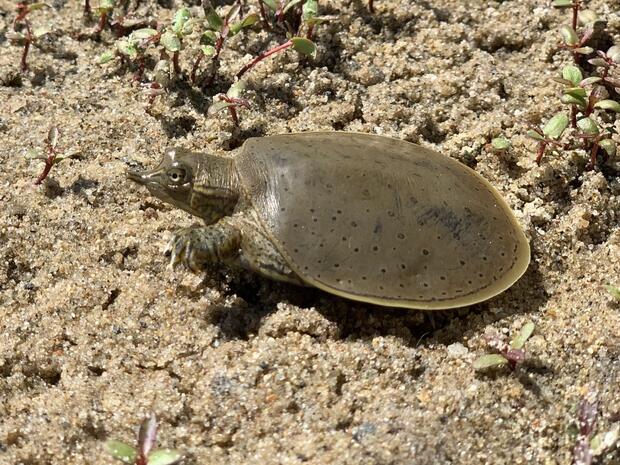Fast facts
Common name: Spiny softshell turtle
Scientific name: Apalone spinifera
Range in MA: Holyoke and Concord, MA
Conservation Status: invasive
Similar looking species: Asian softshell turtle
Identification tip: flat, pancake-like shell that lacks scutes
Description
It would be hard to mistake this large, highly aquatic species for any of our native turtles due to the unique appearance of their flexible, pancake-like shell. It also has a long, snorkel-like, pointed nose, a pair of black-edged, light lines on each side of the head and neck, and strongly webbed feet. It gets its name from small, cone-like projections along the front edge of the carapace. The shell lacks any scales or scutes and, on adult females, feels similar to heavy leather. Adult males typically have tiny projections scattered over the surface of the carapace, giving them a texture more suggestive of sandpaper. Juveniles and most adult males display dark, circular, eye-like spots on a background color of olive gray to light brown, while adult females tend to lose their spots and develop scattered brownish blotches. Shell length can vary in adults from around 6-9 inches (males) to 8-16 inches (females).
Where are they in MA?
Primarily a turtle of sandy-bottomed river habitats, it can also live in lakes and ponds with sand or mud bottoms. In Massachusetts it appears to be established in the Connecticut River downstream of the Holyoke Dam, has been reported from Walden Pond in Concord, and likely has been introduced elsewhere.
Why are they a problem?
Including a number of subspecies, this turtle ranges from the Carolinas and Georgia, west to Texas, and north to Montana and the Dakotas. A disjunct population is also known from Lake Champlain and its tributaries. This species rarely leaves the water except to lay eggs, which are usually deposited in near-shore sand bars and beaches. A typical clutch numbers 6-25 round eggs and is usually deposited in June. Eggs hatch in about 80-90 days. Capable of great bursts of un-turtlelike speed, softshells can be a challenge to capture. Respect the long neck and strong jaws, but specimens can be handled safely, head downward, with a grip on each side the carapace edge near the tail. Typical behavior is to bury itself in sand or mud in shallow water, using its long neck and elongated snout to reach the surface for air. Strongly carnivorous, it feeds primarily on fish, crayfish, amphibians, mollusks, and aquatic insects. Its popularity in the food and pet trades accounts for its propensity to be illegally released, but such releases may introduce exotic diseases to native species, and hence should be avoided. It is not known if it will compete with native species. If specimens of this (or any other non-native turtle) are encountered, please capture and turn them over to personnel at the Division of Fisheries & Wildlife’s Field Headquarters or any District office of the agency. Never release any non-native species into the wild.
